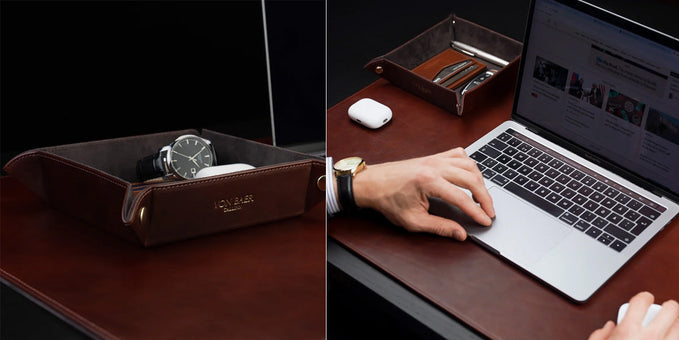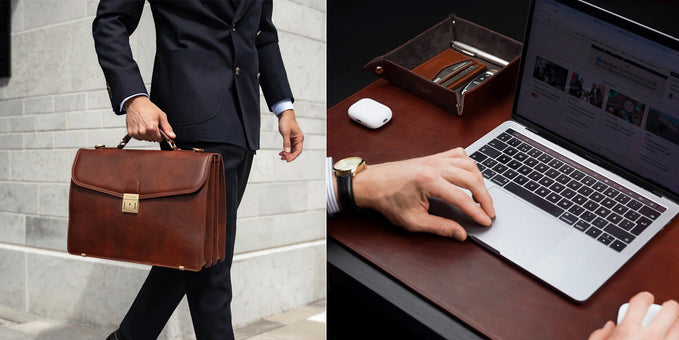Where does leather come from?

This article is all about where leather comes from.
We have more details below, but here are some useful facts about leather production in quick form:
- The word leather refers to processed animal hide.
- This most commonly means cow hide, but leather can be made out of anything from goat, buffalo, snake, alligator, and even ostrich hide!
- More recently, new synthetic leathers have been produced using plastic, as well as plants like mushrooms.
- Cow leather is produced as a byproduct of the meat industry. Though it makes up just 5% of an animal’s monetary value, it is an extremely useful part of it.
- The process involves Curing, Soaking, Liming, Fleshing, Trimming, Splitting, Tanning, Re-tanning, Dying, and Finishing.
- In ancient times, leather accounted for most of the clothing, much of the building material, and even a large portion of the string and rope that people used. This would, of course, have been mostly hides from hunted animals, like deer and bison, but modern industrial agriculture has meant that most modern leather is from domestic cows.
- If the leather industry stopped, this would simply mean more wastage going to landfill, as it uses a byproduct of the meat industry.
We also have this great video on how the Von Baer leather production process works, which is typical for all handmade leather products:
Read on to find out more about leather production:
Where is Leather Produced?

Though cattle are raised almost everywhere, the production of tanned leather takes place primarily in China, Italy, India, Brazil, South Korea, and Russia.
Sometimes the animals are in one country, the tanning takes place in another, and the production of products such as shoes, handbags, jackets or other goods, takes place in another, and the goods are then shipped to the final destination country for sale. Despite this international production network, eighty percent of leather goods are still produced in a single country: China.
Archeological tests have shown that, in early times, leather was commonly made from a wide variety of animals. Whatever was available to trap or hunt, would wind up providing the hides needed to make clothing or other necessary goods. A person in ancient times might be wearing rabbit hide, beaver, goat, deer, camel, alpaca – or even some other animal skin – as part or all of their clothing.
Animals were caught or hunted to provide food, first of all, but tools could be made from the bones, horns (or antlers) and teeth, and clothing and building materials made from the hides. Efforts to protect the hides and make clothing last longer, developed into a sophisticated technology centered around the chemistry of hide preservation. That technology continues to be used, and to grow, today.
All Von Baer leather goods are sourced and handmade in Italy.
Types of Leather
About two thirds (65%) of all leather used in modern times, comes from cows, with sheep hides making up fifteen percent, pig hides another eleven percent, and nine percent from goats. A tiny 0.2% of hides come from other types of animals, but these rare and exotic leathers provide some of the most interesting and desirable raw materials for some products, many of them very high end and expensive.
Related articles:
Cowhide

This is one of the most popular leathers, possibly due to its high availability, in large volumes, as a byproduct of the beef industry. It is no surprise, as the leather is durable, beautiful, comes in a variety of colors and quality levels, and is generally quite a thick, versatile hide.
It is used primarily for clothing (including shoes), handbags and luggage, furniture upholstering, and automobile interiors.
At Von Baer, we use cowhide for all of our leather products.
Sheepskin
Coming in at the second-most used leather type, sheepskin is often used with the fleece still attached, giving it a distinctive – and easily identifiable – appearance. This leather drapes well, and is warm and comfortable, making it a favorite for items like coats and jackets, either as the primary leather used, or as a trim. Sheep hides are also commonly used as rugs or throw blankets.
Pigskin
Pig leather is much denser than other animal hides, and is therefore commonly used in the production of gloves, shoes, and sports equipment. In fact, footballs are commonly referred to as “pigskins” in American slang – a reference to the most common raw material from which they are made.
Goatskin
Goat leather is great for use in glove, bag, and rug production. It is thinner than cowhide, but still soft and malleable and therefore easy to work with.
Exotic Leather
The most exotic leather options, like snake, alligator, ostrich, and so on, are widely available in most places, but often demand a higher price due to their relative rarity. Likewise, since leather is the primary product taken from these exotic animals – rather than a byproduct, as is the case for cowhide – the use of them is protested in many areas. In some cases, the animals from which the hides are taken are endangered species, making hunting them for their leather an unsustainable and unethical practice.
Not all exotic animals are in this category though. In parts of Africa, for example, ostriches are harvested for their feathers, meat, and eggs, as well as for their skin. As an added bonus, ostrich skin has a unique and interesting texture and finished look, as well as being quite robust.
What is the process of making leather?

Leather, as we know it, doesn’t come off the animal that way. It undergoes a long and complex process which changes it from a perishable item to a durable, useful, and widely varying finished product.
This process has not changed a lot in the past few hundred years, but modern technology has made its mark on the process in many ways, not the least of which on the volume of leather being produced, and the efficiency of production.
At Von Baer, all of our leather products are handmade in Italy.
There are ten main stages of the leather tanning process.
Curing
The process begins with curing the hides to slow or stop the natural breakdown of the material.
Soaking
Soaking follows, which usually takes place at the tannery. Hides are soaked in water for several hours, to clean them, and to replace the moisture lost during the curing stage.
Liming
Liming comes next. The hides are stripped of their unwanted hairs, the unwanted proteins are dissolved, and the fiber structure within each hide is opened up, swelling and softening the material.
Fleshing
Fleshing is the removal of any remaining non-hide tissues, such as muscle, sinew, and fat. The hides go into a machine that scrapes and spins them, removing the unwanted tissues mechanically, rather than chemically.
The same process regulates the thickness of each hide and flattens them for easier use when it comes to the patterning and fabrication stages of production.
Trimming
Next, the shape of the hide is modified, with less useful parts of the hide cut away to leave a more uniform, versatile finished shape.
Splitting
The trimmed material is then “split,” which means that it is cut into external and lower layers. The external layer is called the top-grain, and the lower layer is called the split-grain.
Tanning

Then follows the most crucial stage of the process, the tanning. Hides are soaked in tanning agents, which transform the hides’ proteins into a flexible, durable, and versatile material.
This material is more able to withstand wetting and drying, and therefore holds up much better than untanned leather would.
At Von Baer, all hides are hung to dry, which is the most authentic way to produce leather.
The hides then leave their soaking barrel and are sent through a machine that squeezes the excess moisture for them.
At this point, the leather is graded and sorted according to its suitability to certain uses.
Learn more in our post about Leather Tanning.
Re-tanning
For some uses, re-tanning is necessary, and would take place after the Tanning stage. They are then dryed again.
Dyeing
To prepare the hides for certain uses, the hides are dyed and laid out to dry. Additional oils may be applied at this stage to encourage further softening of the material.
Finishing

Finally, the set of chemicals is applied to the surface of the leather to protect the surface. It is now ready for grading.
At Von Baer, we only use the finest full grain leather for all of our products.
Learn more about leather grading and types with these guides:
- Vegetable tanned leather
- What is leather patina
- Wet leather
- What is artificial leather
- What is full grain leather
Ethics of Leather
Whether you’re looking at a handbag, pair of shoes, car seat, or saddle, there is a good chance what you’re looking at was made with leather. That is because leather is both durable, and its beautiful finish is difficult to replicate with synthetic products.
Some people avoid using leather for ethical reasons, also avoiding anything containing meat or animal products. Others are happy to buy leather because, as a byproduct of the meat industry, it is there anyway, and the best way to honor the harvested animal is to use as much of it as possible.
Some avoid using leather with the belief that synthetic products are less harmful to the environment. That is not always the case, however, as some synthetic products are very environmentally damaging – some more than genuine leather.
Leather and the meat industry, what is the connection?
Almost all leathers (99%) come from animals harvested for their meat. Farmers do not raise livestock for their hides (source).
Are animals killed for leather?
No. These animals are killed for their meat. Less than 4% (on average) of the value of a livestock animal comes from its hide.
Is leather a byproduct?
Yes. 99% of leather is a byproduct of the meat industry – the other 1% comes from exotic hides such as crocodile or snake, only some of which is farmed and harvested for meat.
If leather is not produced, the hides are thrown away as waste. The leather industry currently converts about 7.3 million tons of hides into useful leather and leather products. If this were not done, that is 7.3 million additional tons that would go into landfills (source).
If we replace leather does that mean fewer cattle?
No. According to the report “Quantifying the Relationship Between US Cattle Hide Prices/Value and US Cattle Production,” the demand for meat determines the number of cattle raised and slaughtered. This report concluded that leather is a byproduct of that demand, not a driver of it. It also showed that ending leather use would not stop cattle production.
Are we eating less meat?
No. Reports from the Food and Agriculture Organization (FAO) of the United Nations (UN), the global average for meat consumption (per capita) went up from 36.4 kilos per year at the end of the twentieth century, to 41.3 kilos in 2015. Projections by the FAO put average, per capita, meat consumption at 45.3 kilos by 2030 (source).
What happens if we stop using leather?
Ceasing leather production would not stop the production of meat and dairy products – it would only increase landfill loads. These landfill loads would emit an estimated 6.6 million tons of greenhouse emissions per year.
We do not use hides and skins for other purposes to any significant degree.
Related links:
- Leather guide for beginners
- Is leather waterproof?
- What makes leather products organic?
- How long does a leather bag last?
If we stop eating meat what happens to leather?
If we stop eating meat, the animals currently raised for that purpose would not be raised. They are not wild animals, and so they would simply disappear, mostly or completely. Since leather is a byproduct of the meat industry, if meat production ceases, there would be no leather available. This would also mean the loss of 1.3 billion jobs, globally, which exist in the various livestock production chains.
However, since per capita meat demand is growing, and population as a whole continues to grow, the use of leather is a logical way to reduce waste and greenhouse damage produced by what would otherwise be discarded into landfills.
Conclusion
We hope you enjoyed our article on where leather comes from.
If you have any questions or comments, contact us at info@vonbaer.com, or leave them in the comments.

Author: Albert Varkki
Albert Varkki is the co-founder of Von Baer. He understands leather products as a consumer, supplier, and a manufacturer, helping you with the inside knowledge you need, to choose the perfect leather product for you.
We strive for the highest editorial standards, and to only publish accurate information on our website.
Leave a Comment
Your email address will not be published.






